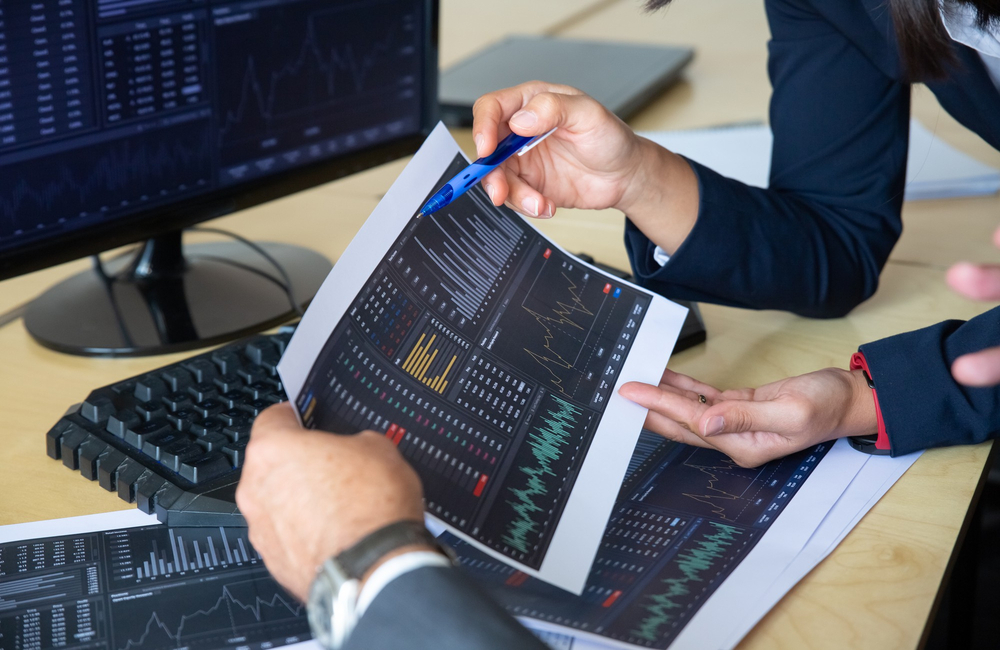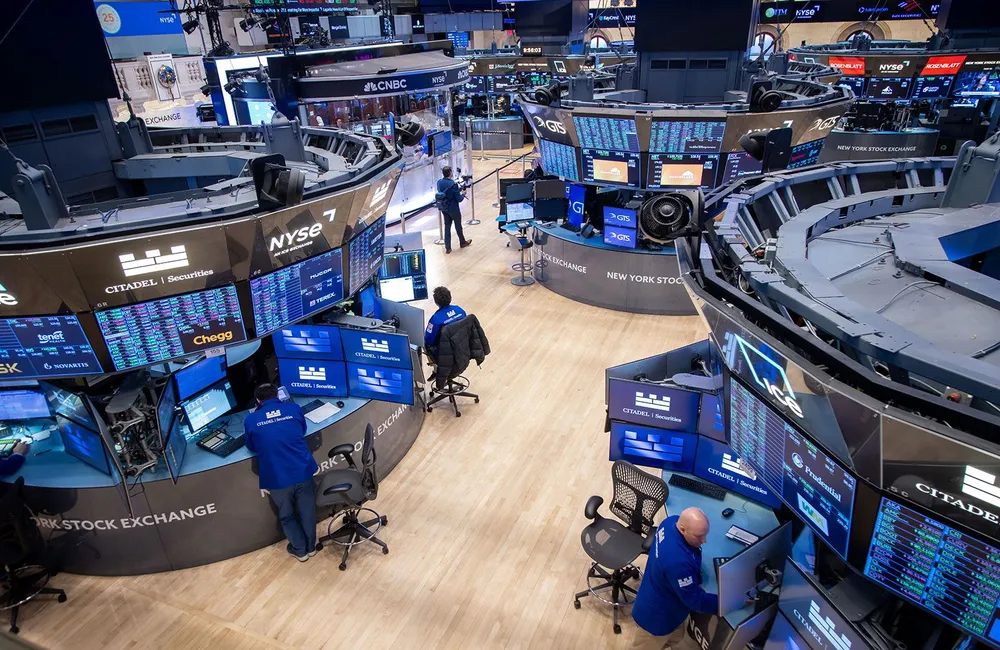ASX futures were 106 points, or 1.5% higher to 7290 at 8:00 am AEST, indicating a positive start to trading.
The S&P 500 climbed 2.2 percent, adding to Tuesday’s gains for its largest two-day gain since April 2020. The Nasdaq Composite, which is heavy on tech, rose 3.8 percent, its largest single-day gain since November 2020. The Dow Jones Industrial Average gained 519 points, or 1.55%.
The indexes pulled back at first after the Fed’s widely expected announcement, then bounced back during Chairman Jerome Powell’s news conference. Powell said the U.S. economy was robust enough to endure a tighter policy and played down the risk of a recession. That’s what Fed officials are signaling, projecting six more rate increases this year one at every remaining meeting.
“This very much feels like they want to send a message that they’re fighting inflation, and they’re going to fight it fast and get it under control,” said Kathy Jones, chief fixed income strategist at the Schwab Center for Financial Research.
Fed officials raised rates as global stocks climbed Wednesday on positive developments on two of the great concerns currently holding markets in thrall: Russia’s war in Ukraine and the new outbreak of COVID in China. Russian and Ukrainian negotiators have touched on a peace plan, with tentative progress, according to a report on Wednesday by the Financial Times. Earlier, the Chinese government soothed plummeting equity markets after a senior official pledged to take steps to “boost the economy in the first quarter.”
At home, the S&P/ASX 200 finished 1.1% firmer at 7175.2, with all sectors up as expectations of interest-rate hikes at home and abroad supported stocks.
The two heavyweight components of the ASX 200 by market capitalization, the financial and materials sectors, gained 1.05% and 0.4% respectively.
Tech stocks drove gains, dragging the troubled sector up 3.3%. Block’s ASX-listed securities were the worst name from the ASX 200: up 7.0% on the Nasdaq Composite’s outperformance in the US on Tuesday.
Xero, WiseTech, Appen and Life360 gained between 4.1% and 7.4%. Energy was the worst-performing sector despite inching less than 0.2% higher.
Magellan soared 3.9% after announcing a plan to buy back as much as 5.4% of its stock or 10 million shares. Shares are down 21.4% for the month.
In commodity markets, gold futures eased 0.2% to $1925.80; Iron ore soared 7.3% to US$145.45 a tonne; Brent Crude consolidated around US$100, down 1.8% at US$98.09.
US long-dated government bonds plunged on Wednesday after the US Federal Reserve increased interest rates, then recovered in late afternoon trading. US 10-Year Treasury Note increased to 2.19%, from 2.14% the previous day. The yield on the Australian 10-year bond dropped to 2.49%. Yields rise when prices fall.
The Australian dollar recovered overnight and was last up 0.1% at 72.92 US cents as at 8:00 am AEST, rising from a previous close of 71.94. The WSJ Dollar Index, which measures the US dollar against 16 other currencies, ticked down to 91.36.
Asia
Chinese stocks closed sharply up, recovering from a rout in the previous two days, as investor sentiment lifted on supportive comments from senior officials. During a meeting led by President Xi Jinping’s top economic adviser, Vice Premier Liu He, policy makers said the two countries are making efforts toward establishing a “concrete cooperation plan” over accounting oversight of American-listed Chinese firms. Concerns about potential ADR delistings for these companies have been among the key drivers of the latest selloff. The benchmark Shanghai Composite Index soared 3.5%, and the Shenzhen Composite Index gained 3.6%. The tech-heavy ChiNext Price Index was the biggest winner, gaining 5.2%.
Hong Kong stocks soared on Wednesday, with the benchmark Hang Seng Index ending up 9.1 percent, its largest one-day increase since 2008. Comments from top Chinese economic policy makers were supportive, and were enough to boost shares “since there would be ‘coordinating pandemic prevention and control and economic development, keeping the economy operating within a reasonable range and keeping the capital market running smoothly,’” state-owned Xinhua reported. Shares of tech tumbled, with JD.com, while Meituan and Alibaba Health Information Technology surged 35 percent, 32 percent and 28 percent. The Hang Seng TECH Index rose 22%.
Japan’s Nikkei Stock Average climbed 1.6%, with the drop in crude prices encouraging risk-on sentiment. The overnight tumble in oil prices propelled a relief rally on Wall Street that spilled over into Asia today, Oanda says. Nikkei gains were widespread, with SoftBank Group surging 5.95%, Fujitsu Ltd. gaining 5.4% and Shimano adding 4.9%. Airline shares were also up, including a 5.2% rise in Japan Airlines Co and a 2.8% increase in ANA Holdings Inc.
Europe
European markets were boosted by the easing of tensions and some hints of economic stimulus in China. The pan-European Stoxx Europe 600 rose 3.1 percent.
“Stocks have put in a very solid step forward this afternoon, driven by some good news on two key issues,” says Chris Beauchamp, IG analyst. “China stimulus headlines and Ukraine deal reports will always give stocks a leg-up, and to combine the two in the same day has got risk appetite soaring in fine style.”
The FTSE 100 in London finished up 1.75 percent on Wednesday in a renewed risk-on mood from investors after two pieces of good news: stimulus headlines out of China and an ambitious proposal to end the war in Ukraine.
“It is very much a risk-on day for the London market, with gains spread across a host of names and sectors and the only real losers — aside from Avast PLC — being utility stocks, which have been unceremoniously dumped in the rush back into other names," says Beauchamp.
There are still many hurdles to cross, particularly with an imminent Federal Reserve decision, but Chinese stimulus and hints of a peace deal could help assuage fears, not least over skyrocketing commodity prices, Mr. Beauchamp says.
North America
US stocks rose in a choppy session and bond yields soared Wednesday after the Federal Reserve signaled for the first time since 2018 that it was looking to raise interest rates.
The S&P 500 ended the day up by 2.2 percent. The tech-heavy Nasdaq Composite gained 3.8%, while the Dow Jones Industrial Average added 519 points, or 1.55%. The indexes began the day paring their gains after the Fed’s announcement but rallied when Chairman Jerome Powell spoke at a news conference.
The Fed increased interest rates by a quarter-percentage-point as officials try to prevent the economy from running too hot and to rein in inflation. New forecasts indicate most officials expect the fed-funds rate will be at least 1.875% at the end of this year and around 2.75% at the end of 2023. That means seven quarter-percentage-point increases in 2022 and more in 2023.
“It seems very much like they wanted to send a message that they’re fighting inflation and they’re going to fight it fast and get it under control,” said Kathy Jones, chief fixed income strategist at the Schwab Center for Financial Research.
But some investors recently had reduced their expectations for rate increases this year as a result of the Ukraine crisis. The central bank is grappling with an unusually complex backdrop of a tight labour market, supply snarls, runaway inflation and the fallout from Russia’s invasion of Ukraine and tighter Covid-19 restrictions in China, which is likely to worsen inflationary and supply-chain woes.
The Fed’s interest-rate hike on Wednesday signals the end of an unprecedented wave of stimulus that was enacted as the Covid-19 pandemic was tearing through the US. The virus ended a yearslong bull market in stocks and pushed the economy into recession. The Fed’s stimulus has propelled the economy to recover more quickly than many expected and propelled stock markets to record levels. Now, investors have a new challenge: inflation at a 40-year high. Others are even anxious about a coming recession.
The possibility of Fed interest rate hikes has shaken markets for months. The Nasdaq Composite is headed for its longest bear market since the financial crisis. The S&P 500 has fallen about 10 percent from its peak.
Bond yields climbed following the announcement. The yield on the benchmark 10-year Treasury note rose to 2.192% from 2.160% Tuesday. Yields and prices are inversely related. The steep rise in bond yields is a sign of investors increasingly betting that Russia’s invasion of Ukraine won’t slow down the momentum toward rising interest rates.
US retail-sales data for February showed an uptick in spending from the month earlier as households adjusted to the crosscurrents of a robust labour market, easing coronavirus infections and inflation running at its fastest annual pace in 40 years.
Oil market movements were subdued as investors considered whether lockdowns in some Chinese cities will diminish demand for energy even as Russia’s invasion of Ukraine has heightened concerns over supply disruptions. Brent-crude futures, the global benchmark, slipped 1.9% to $98.02 a barrel.
Rising oil prices have raised fears that the US and Europe will see sustained inflation and weaker growth, as higher prices for gas and energy cut into household spending on other goods and services. Oil prices dipped below $100 a barrel in recent days, buoying the stock market.
Shares of tech and growth companies, which have been pummeled in recent months, did especially well in trading on Wednesday. The ARK Innovation ETF climbed 8.6 percent. Shares of Nvidia surged 6.3%, and PayPal shares gained 7%.
In a statement on Wednesday, Chinese officials vowed to “coordinate pandemic prevention and control and economic development, keep the economy operating within a reasonable range and keep the capital market running smoothly,” according to the state news agency of China. That calmed some fears about an economic slowdown in China that would also batter growth elsewhere in the world.
Technology stocks led a blistering rebound among Chinese markets following supportive comments from policymakers in Beijing. Hong Kong’s Hang Seng Index leapt 9.1 percent, driven by technology stock advances. The Shanghai Composite in China rose 3.5%.
“The rebound in Chinese equities tells you how jittery the markets are,” said Peter Garnry, the head of equity strategy at Saxo Bank, adding that there had also been wild swings in markets over the past several weeks as investors reacted to headlines across various happenings.





















